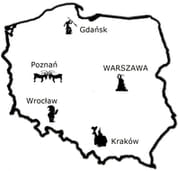Nestled in southeastern Poland, Zamosc is a remarkable city whose genesis dates back to the late 16th century. Founded by Chancellor Jan Zamoyski on a vital trade route linking Western and Northern Europe with the Black Sea, the city was conceptualized as an ‘ideal city’ following Italian Renaissance urban theories. The mastermind behind its architectural elegance was Bernando Morando, a Paduan architect whose designs have left an indelible mark on the cityscape. And the most important thing – the streets of Zamosc and its layout remained untouched until today.
Zamosc Market Square
Zamosc historical core radiates from the Great Market Square (Rynek Wielki), where the most photographed edifice, the Town Hall, stands with a grandeur that narrates tales of the bygone era. The Town Hall, along with the surrounding old town, is a part of the UNESCO World Heritage listing, emphasizing the city’s historical significance and architectural splendour.

Armenian tenement houses
Armenian tenements – historic Mannerist-Baroque tenements in the Old Town of Zamosc, located in the northern frontage of the Rynek Wielki, on Armenian Street.
This part of Zamosc was granted by the founder of the town, Jan Zamoyski, to Armenians, hence the name of the street and the tenements. They were mainly built in the middle of the 17th century and, like the other frontages of the Market Square, have arcades. Each belonged to different owners, and after World War II they passed into state ownership (the last owners were mainly Jews). The 5 townhouses to the right of the Town Hall have a special appearance – they are decorated with bas-reliefs, friezes, ornaments and attics, which were restored during the renovation of the Old Town in the 1970s under the direction of architect Wiktor Zin.
18 townhouses are listed in the register of historical monuments.
Other points of interest
As you traverse the cobbled streets of Zamosc, a visit to the Zamosc Cathedral and the Synagogue unveils the religious tapestry and architectural diversity of the city. The Zamosc Museum and the Museum of Fortifications and Weapons “Arsenal” further enrich the historical narrative, offering glimpses into the city’s military and cultural past.

The legacy of the Zamoyski family resonates through the city, especially in the Palace of the Zamoyski Family (Prochownia+ Arsenal), a monumental edifice that stands as a testament to the city’s aristocratic lineage. The Zamoyski family’s history is intertwined with the city’s governance, a unique aspect that accentuates the city’s historical narrative.

Zamosc, with its rich history, architectural marvels, and natural splendours, offers a multifaceted experience for the discerning traveler. Each street, monument, and natural site narrates a story, making a visit to Zamość a journey through the annals of history, the aesthetics of Renaissance architecture, and the serene embrace of nature.
